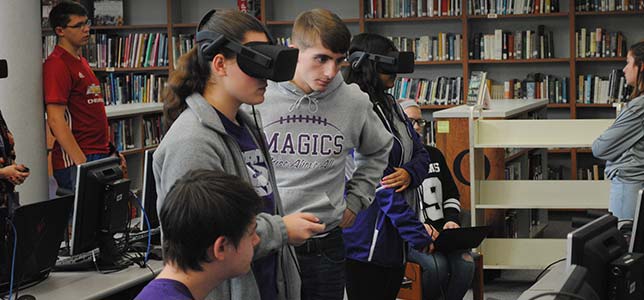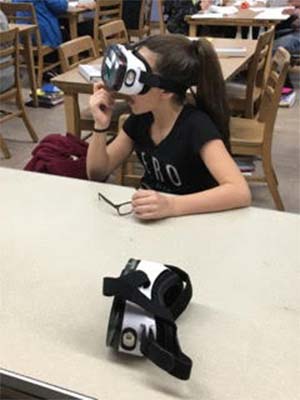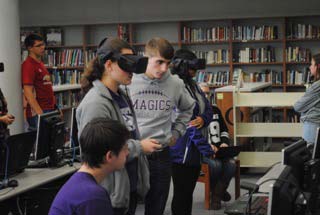Teaching with AR & VR
Making Virtual Reality a Reality in Today's Classrooms
- By Meredith Thompson
- 01/11/18

The market for virtual reality applications is growing at a rapid pace, and is expected to double in the next five years (Bolkan, 2017). As the cost of equipment falls and schools have greater access to technology, there is great interest in virtual reality as an educational tool. A small but growing group of educators have started to integrate virtual reality in their classrooms, with promising results (Castaneda, Cechony & Bautista, 2017). We reached out to teachers and administrators who are currently using virtual reality in their classrooms to hear their perspectives and practical strategies for infusing this resource into their classrooms.
Teachers have creative ideas for how to incorporate immersive education in current classrooms: how to select activities, how to set up the classroom, how to get support during the activity and how to transport devices. Teachers also shared their ideas for future applications of VR, including how to deepen the learning experience and to expand the reach of these technologies to a greater population of students.
Here we share three vignettes of three different approaches: a social studies class in a suburban school district, a district-wide perspective from an urban school district and a class designed entirely around understanding and implementing VR for other classrooms. We also share how we are using these ideas to inform our own project in designing a collaborative immersive virtual reality educational game for introductory high school biology.
Exploring the World from Within the Classroom Walls
Part of learning about immigration in Melinda Lohan's high school classroom in Medfield, MA is a virtual visit to both Ellis Island and Angel Island. "Most of my students have been to Ellis Island, but most haven't been to Angel Island", Lohan explained, "They can see two entry points for immigration and how it has changed based on the current political climate."
Lohan has been using virtual field trips in her class for three years, after being introduced to the experiences during a digital learning day sponsored by the technology specialists in Medfield. Students use their own phones during the activity, and the school supplies the viewers. Initially, there was some turbulence. "The first time I tried it, it was totally a disaster. The WiFi didn't work, the students could not get set up.."Now she asks her students to download the field trip app to their phones on the first day of school as a homework assignment and asks the students to keep the application on their phone or accessible in the cloud for easy access. "The more you can set up in advance, the easier it will be."
Using a flipped classroom model, Lohan's students watch her lectures on YouTube and do their notes at home, which gives them time to focus on activities during class. She provides guiding questions to keep them focused on the learning objective but lets students choose how they watch the virtual reality field trips. "There is a lot of movement in the field trips and so they can get dizzy. I let them do what they want — stand, sit, lie down on the floor. I also have a screen so they can mirror a phone for the group in case the WiFi cuts out." Lohan's experience with virtual field trips is evident when she quickly adds, "I make sure to tell the students to turn off their notifications before they share their screen with anyone. Once I didn't tell the kids to turn off their notification, and a snapchat came up while we were looking at one student's phone. She was mortified. So, now I always remind them at the start of class." The school helpdesk, staffed by high school students, also provides support if the WiFi is variable or the devices are not working properly.
Lohan has found many ways to weave the field trips to her curriculum. Students virtually visit the Tenement Museum when they talk about Industrialization and visit the Normandy Beaches and the Holocaust Museum when they do their unit on World War II. The field trips turn social studies into an active learning experience, and her students are eager to try them out. Lohan is also strategic about how often she uses virtual field trips in her unit plans. "The kids love them. However, I think whenever you do something too frequently the students get immune to it. We don't go on a field trip every chapter. If you do it every single time then it's not as engaging."
Thinking ahead, Lohan would love to have students be able to make and test critical decisions in history. "I'd like them to be able to make decisions that could change history. To decide on whether or not you're going to have the draft or what you're factories are going to look like. I wish they had access not only to view but also to create. That's when they learn the most — not by looking at someone else's work, but by creating their own".
Coordinating Cross-District Logistics

An elementary student in Fitchburg MA views a virtual field trip during class.
For the last two years, Eileen Spinney and Chris Turner have helped teachers integrate virtual reality into their classrooms in Fitchburg, MA. Eileen is the district director of instructional/informational technology, and Chris is the district data/instruction/professional learning technologist. The experience of integrating virtual reality lessons in eight different schools ranging from elementary to high school has made them masters of logistics. "We have a pack of 30 phones and smaller packs of five phones that are district resources," Spinney explained. "We have kits and containers that Chris has designed, and they are pretty mobile." One challenge they have faced sharing the equipment across multiple classes is keeping the devices charged. To address this issue, Turner repurposed photography carrying cases into portable "tech tubs" complete with rapid charging cords so the devices can be charged easily and compactly in between classes. Spinney adds "We schedule times to charge the devices."
Before class, they set up the devices on a counter or table and get the screens lit up and on the school's WiFi network. Once the teacher's laptop is activated, they distribute the devices table by table. Different age ranges pose different challenges. In the middle and high school, teachers see multiple classes, so they can set up the equipment in one classroom. In the elementary school, the virtual reality equipment moves from class to class since classes are self-contained. Once the devices are transported, distributing 30 devices to eager elementary students can be a challenge, so volunteer parents and district Title I Parent Liaison Eva Kelly also help the teachers in class. Turner and Spinney have also created smaller sets of devices. FPS Assistant Superintendent Paula Giaquinto explained, "We've had most success with the smaller groups. We have about five to six students interacting with the VR where others are rotating through centers or other aligned, academic activities they are involved with."
"Our district demographics are challenging," Giaquinto explained. "We are an urban district in north central Massachusetts. Even though we are less than an hour from the ocean, many students have never been to the beach." These virtual field trips have brought Fitchburg students to the desert, the rainforest and the tundra to experience the Northern Lights. Paula recounts a story about a class who was viewing the YouTube movie Elephants on the Brink after reading parts of the novel A Long Walk to Water. "One child was so engrossed in the video experience that, when someone went by and brushed their shoulder, the child exclaimed 'the elephant touched me!' — these experiences are absolutely immersive."
Finding available applications is a joint effort between the administration and the teachers. Thus far, teachers have primarily drawn from Google Expeditions, Discovery Learning and YouTube education. The STEM coordinator in the district, Jessica Stodulski, has collected a number of resources, as well as the content coaches for Math and Literacy/English. The teachers in the district are contributing too. When resources are unavailable, the teachers are creating their own. They recorded a field trip to the butterfly garden to bring to the elementary school students during their unit on monarch migration. After talking with a competitor in the Iditarod dogsled race, they asked them to film the experience. Giaquinto explained, "I believe last year the group that was involved in the race was filming VR footage for us for this year — that's still in progress."
Now that teachers are experienced in using virtual reality in their classroom, the Fitchburg technology team plans to incorporate more interactive virtual reality equipment that allows students to interact with each other. They are currently investigating Oculus Rift and Vive. "Right now, the field trips are mostly guided — we would like to have students fully participating in this. Right now the way we have used virtual reality is strategic, but it's more like parallel play. We want to have students take information and try things and test things out in the virtual world."
Creating Educational Virtual Reality Lab
Students come into David Kaser's classroom and gather their tools from two different carts — a laptop and a backpack containing an Oculus Rift. It takes about 10 minutes for the class of 19 students to set up 10 Oculus Rifts around the classroom. "It looks pretty spectacular, but chaotic," Kaser said, "but we use the classroom for other things, so that doesn't allow me to leave the VR set up permanently."
The students are currently selecting and analyzing applications that use immersive 3D virtual reality within the classroom; however, the experience Kaser's high school students gain in setting up and breaking down the Oculus Rifts and laptops will soon come in handy. After the students curate a database of VR activities, the class will transition from evaluating educational applications to supporting teachers in implementing those applications in classrooms. "We have a selection process where we choose one app to focus on. Then, as an entire class, they research and become experts at using it. We meet with the classroom teachers, schedule the time it will take, take the equipment to them, set it up and work side by side with students in the activity." Through this experience, Kaser's students evaluate software, become technology mentors and reinforce their own understanding of the content in the applications.

One of Kaser's STEM VR students assists a pair students in the health class. Both students go through the experience, with the student in the headset relaying information to the person taking notes on a computer.
In late 2016 these ideas were just scribbles on Kaser's yellow notepad. As a high school technology teacher, Kaser has a fair amount of latitude in the type of classes he teaches, and he envisioned a class about virtual reality in education. The biggest barrier, as for many educators, was the money involved in purchasing the equipment. He wrote and obtained grants from a local foundation, Barberton Community Foundation, PPG Industries and the Arconic Foundation, which funded a large part of the purchases. "When the grant application process was going through we didn't have the equipment so I couldn't say 'come in and see it.' Now we have the equipment, and people can come into the lab and try it out. When visitors come in, I have the students work with them. The students set them up in the headset and talk them through the basic controls. It's good practice for the students." Kaser said he plans to take his class of students and the equipment to the upcoming Ohio Ed Tech Conference (OETC) to introduce other teachers to the applications and idea of using VR in their classrooms. He explained, "We will present what we have done and how we set it up — each of the 15 Oculus Rifts will have a different educational application running in to the headset. I also want to have students research different VR technologies — Samsung, Google cardboard, Vive, so they can share that information with other teachers. The students are excited to be a part of it."
Realistic Virtual Reality
These three examples provide some insight into how to infuse virtual reality realistically for the classroom. In some cases, students bring their own phones while the school supplies the headsets; in others devices are shared district-wide from a central office or even housed in a classroom and shared across schools. Finding ways to transport and charge devices between classes can involve retrofitting existing backpacks or modifying photography or audiovisual equipment. Teachers can find support from administrators and parents or involve students as tech support in their classrooms. Teachers, administrators and schools can help find and evaluate educational applications. And everyone can ensure that virtual experiences heighten engagement and support academics.
At MIT, we are developing virtual reality applications that can are feasible in today's classrooms but also push the boundaries of educational VR applications. The MIT Education Arcade and MIT Game Lab are currently working on Collaborative Learning Environments in Virtual Reality, or CLEVR. CLEVR is an interactive, immersive game where introductory biology students will work together to learn about cellular biology and the central dogma (DNA to RNA to protein) in order to diagnose a problem in a cell. Through designing the game, we are also investigating how to create virtual reality environments that can be interactive and collaborative and can enable students to incorporate their own designs and creativity. We are talking with cell biologists and medical experts to create an authentic environment. CLEVR will be informative and fun and will capitalize on virtual reality's ability to transport students to a place that is otherwise impossible to experience: the inside of a human cell.
Current uses and resources for VR focus on individual experiences with limited interactivity such as virtual field trips and guided tours. While sensory immersion can be powerful, these uses do not capitalize on the power of the medium. The next steps in 3D immersive VR in the classroom should leverage the ability for students to explore spatial relationships such as architectural designs and chemical structures, to involve local and remote learners to collaborate and to enable students to integrate different types of data (graphs, charts and 3D models) in meaningful ways (Hew & Chung, 2010). Immersive 3DVR has the potential to change how students engage with those topics, and large scale implementation of 3D immersive VR scale should capitalize on how this medium can push the boundaries of learning in new dimensions.
References
Bolkan, J. (2017, December 04). Virtual and Augmented Reality to Nearly Double Each Year Through 2021. Retrieved December 07, 2017, from https://thejournal.com/articles/2017/12/04/virtual-and-augmented-reality-to-nearly-double-each-year-through-2021.aspx
Castaneda, L., Cechony, A., Bautista A.. (2017) Applied VR in the Schools, 2016-2017 Aggregated Report. Foundry 10. Accessed 12/1/17. http://foundry10.org/wp-content/uploads/2017/09/All-School-Aggregated-Findings-2016-2017.pdf
Hew, K. F., & Cheung, W. S. (2010). Use of three-dimensional (3-D) immersive virtual worlds in K-12 and higher education settings: A review of the research. British Journal of Educational Technology, 41(1), 33–55. http://doi.org/10.1111/j.1467-8535.2008.00900.x
Bolkan, Joshua. (2017) Virtual and Augmented Reality to Nearly Double Each Year Through 2021. THE Journal.